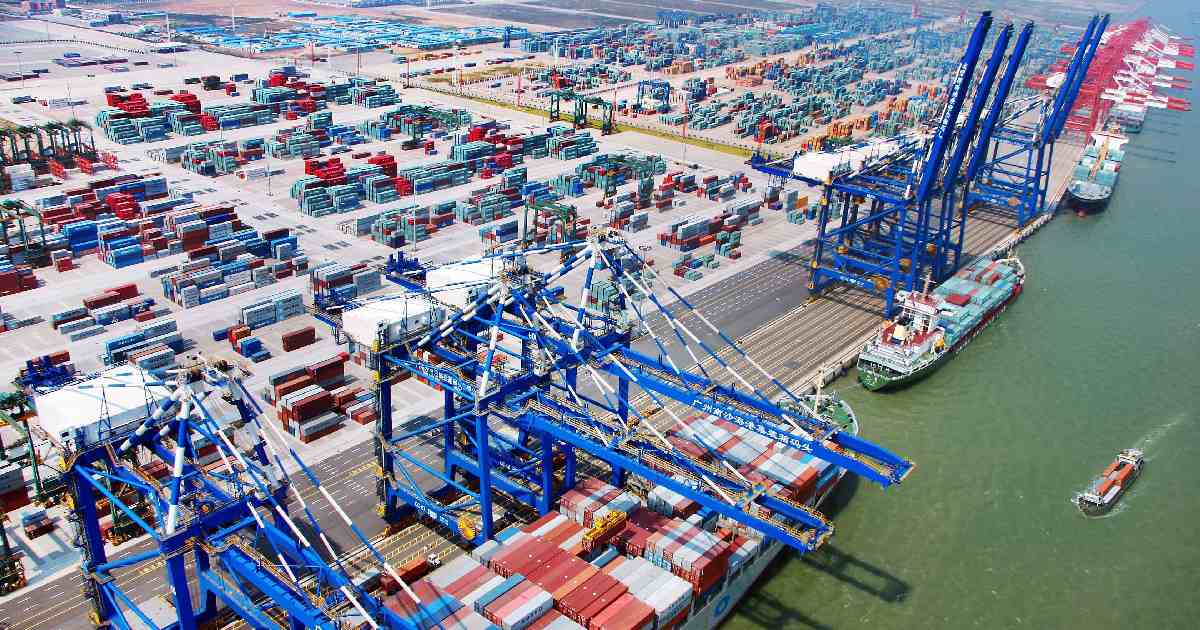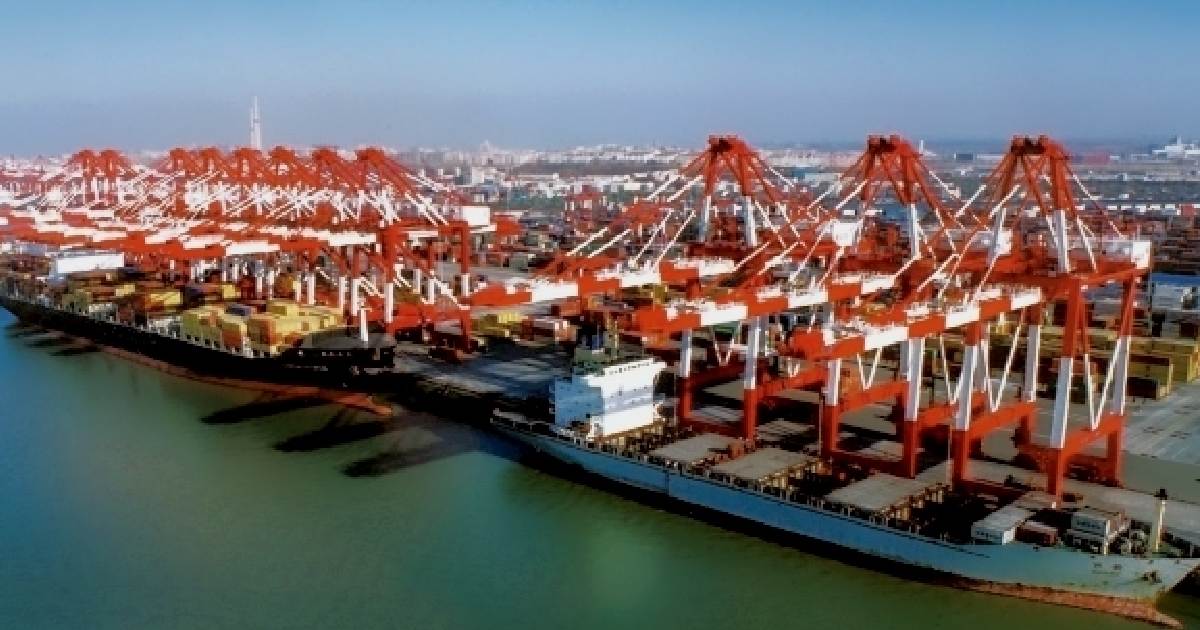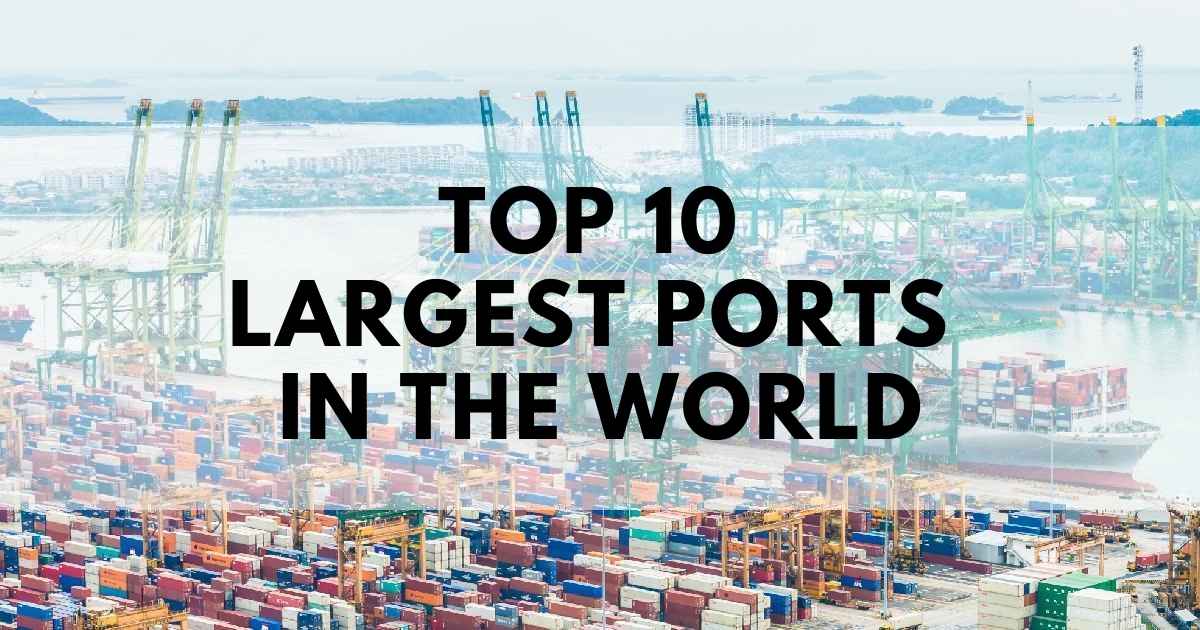International trade and cross-continental transportation rely on ports. Every year, the world’s largest ports transport countless twenty-foot equivalent units (TEUs) successfully. The swift movement of commodities across these busy maritime gateways promotes regional economies and strengthens the worldwide supply chain. This article tackles the world’s top 10 largest ports, their features, and their effect on global trade.
10. Port of Hong Kong

- Million TEU: 17 million TEUs
- Terminal: Kwai Tsing Container Terminals
- Key Features: Major transshipment hub, critical to Southeast Asia trade, world-class container facilities
The Port of Hong Kong transports 17 million TEUs annually, making it one of the most active. It is a significant transhipment hub for Southeast Asian and international goods. The port’s central container terminal, Kwai Tsing Container Terminals, is capable of handling a large traffic of containers.
Due to its geographic location in Asia, Hong Kong is an integral part of global trade networks. It ensures that goods can easily move between China, Southeast Asia, and the rest of the world. The port’s strategic location and superior infrastructure keep it a major worldwide trade center.
9. Port of Los Angeles/Long Beach, USA

- Million TEU: 17.5 million TEUs combined
- Terminal: Middle Harbor Terminal (Long Beach)
- Key Features: Largest port in the United States, critical link for trans-Pacific trade, extensive container handling facilities
The most extensive and most engaged container port compound in the United States is made up of the Port of Los Angeles and the nearby Port of Long Beach. Together, they handle 17.5 million TEUs throughout the year. These ports of entry are vital to U.S. foreign trade as the main entry for Asian products, especially from China.
Shipping handling services are the most modern at both ports. Long Beach’s Middle Harbor Terminal is renowned for its sophisticated, computerized systems. For trans-Pacific trade, the West Coast ports link the U.S. economy to global marketplaces.
8. Port of Tianjin, China

- Million TEU: 21 million TEUs
- Terminal: Dongjiang Port Area
- Key Features: China’s northern trade hub, international passenger terminal, extensive container traffic
Tianjin Province near Beijing, is China’s major north trading port. One of the world’s finest container ports, Tianjin, processes 21 million TEUs every year. Commerce Worldwide capitalizes on the Dongjiang Port Area shipping center.
A lot of merchandise going in and out of both domestic and foreign markets passes through Tianjin daily. It serves as northern China’s main maritime gateway. Their international passenger terminal encourages business and tourism trips.
7. Port of Busan, South Korea

- Million TEU: 22 million TEUs
- Terminal: Busan New Port
- Key Features: South Korea’s largest port, leading transshipment hub, links Asia to Europe and the Americas
Busan, South Korea’s largest port, transports roughly 22 million TEUs once a year. It connects Asia to Europe and the Americas as a transit center near the southernmost point of the Korean Peninsula. Busan New Port, its biggest container terminal, has contemporary amenities that guarantee effective operations.
Busan is of paramount significance to South Korea’s economic growth, especially for companies that depend on shipments. Key routes for shipping render the port a crucial part of international trade networks. Thus, guaranteeing Asian goods reach international markets in a timely manner.
6. Port of Guangzhou, China

- Million TEU: 23.2 million TEUs
- Terminal: Nansha Terminal
- Key Features: Southern China’s largest port, strong link to global supply chains, bulk cargo and container traffic hub
In southern China, the Port of Guangzhou imports 23 million TEUs yearly. The port’s versatility allows vessels and bulk cargo to travel smoothly across the borders of China’s industrial region. The port’s essential container building, Nansha facility, accommodates large international shipping containers.
Guangzhou is one of the nation’s oldest ports and an emerging international economic hub. It is an essential asset for China’s trade network due to its central position near Hong Kong and its incorporation into the global supply chain. This has made it accessible to China to foster business with the majority of the world.
5. Port of Qingdao, China

- Million TEU: 24 million TEUs
- Terminal: Qianwan Container Terminal
- Key Features: Northern China’s key port, strategic location on the Yellow Sea, large container ships dock regularly
Port of Qingdao is another major player in China’s vast port network, handling over 24 million TEUs annually. A vital marine route for internal and foreign trade, Qingdao sits in China’s north on the Yellow Sea. Its largest terminal, Qianwan Container Terminal, accommodates cargo from foreign ships.
Japan, South Korea, and many other adjacent nations rely upon Qingdao for trade. The port welcomes huge freighters that give away products for China and farther afield. Its strategic importance continues to grow as global trade flows through northern China’s vital economic corridors.
4. Port of Shenzhen, China

- Million TEU: 30 million TEUs
- Terminal: Yantian International Container Terminal
- Key Features: Southern China’s primary port, hub for high-tech goods, busiest container terminals in the world.
In southern China, the Port of Shenzhen is one of the busiest ports in the world. It is vital for global trade, particularly among high-tech items made in China’s manufacturing heartland, carrying 30 million TEUs annually. Yangtian International Container Terminal in Shenzhen manages significant container traffic.
The port is readily accessible to the telecommunications and electronics industries. Ships from across the world regularly dock at Shenzhen’s ports, which plays a major part in assisting the flow of commodities to Europe, the Americas, and various other countries. Shenzhen serves as an essential interface connecting China and the global market.
3. Port of Ningbo-Zhoushan, China

- Million TEU: 31.1 million TEUs
- Terminal: Beilun Port Area
- Key Features: China’s leading bulk cargo hub, extensive container terminal network, connection to northern China
Located in Zhejiang Province, the Port of Ningbo-Zhoushan ranks as one of the largest ports in the world, handling over 31 million TEUs annually. The port is a key player in international trade, thanks to its extensive container terminal network that accommodates vast amounts of container traffic. The Beilun Port Area, one of the port’s main container terminals, is particularly significant for containerized cargo.
Ningbo-Zhoushan’s location makes it a vital link between northern China and the global trade network. It specializes not only in container handling but also in bulk cargo, making it one of China’s most versatile ports. The port’s growing importance in international trade continues to rise as it expands its capacity to handle container ships and contributes to the country’s economic strength.
2. Port of Singapore, Singapore

- Million TEU: 37.5 million TEUs
- Terminal: Pasir Panjang Terminal
- Key Features: Busiest transshipment port, largest maritime gateway in Southeast Asia, world-class container terminal
Singapore is the second busiest container ports in the world. As a marine gateway, it arranges Southeast Asian and international commerce. The port is a major transhipment hub, transporting 37 million TEUs yearly.
The country’s primary container ports, notably Pasir Panjang Terminal, are functional and sophisticated. The port’s advantageous position along major transport lines attracts Indian Ocean-Pacific container vessels. Its modern infrastructure and strong service standards help Singapore maintain its global trade leadership.
1. Port of Shanghai, China

- Million TEU: 47 million TEUs in 2023
- Terminal: Yangshan Deep-Water China Port
- Key Features: Largest automated container port, maritime gateway to the East China Sea, hub for global trade
The Port of Shanghai is the world’s largest and busiest shipping port. It is a crucial seaport, ideally placed on the coast of the East China Sea. Processing about 47 million TEUs annually, the port is important to worldwide trade. Shanghai Port has the world’s largest computerized container port, Yangshan Deep-Water Port, which enhances handling of cargo and efficiency.
Multiple container depots handle bulk goods and foreign trade at the port. Its contemporary infrastructure handles large shipping containers, assuring smooth merchandise exchange within and outside of China, a global trade powerhouse. Given its location, the port is a vital stopover for container ships traversing the East China Sea. This maintains that it remains the busiest port in the world.
Conclusion
The largest ports in the world are the lifeblood of global trade, ensuring the smooth movement of goods across continents and oceans. These ports, from the world’s busiest port in Shanghai to the vital transhipment hub in Singapore, handle millions of TEUs and play a critical role in sustaining international trade. With advancements in automation and infrastructure, these ports continue to evolve, driving the global economy forward and cementing their place as essential nodes in the global supply chain.
Frequently Asked Questions (FAQs)
What is the largest water port in the world?
The largest water port in the world is the Port of Shanghai, China. It handles over 47 million TEUs annually, making it a vital hub for global trade. This maritime gateway, located on the East China Sea, is equipped with advanced infrastructure, including the largest automated container port in the world, Yangshan Deep-Water Port.
What is the busiest seaport in the world?
The busiest seaport in the world is the Port of Shanghai in China. Handling over 47 million TEUs in container traffic annually, it surpasses all other ports in both scale and efficiency. Strategically located on the East China Sea, it plays a crucial role in global trade, connecting China with major markets across the globe.
What is the largest natural port in the world?
The largest natural port in the world is the Port of Sydney in Australia. Known for its deep waters and natural harbor structure, Sydney Harbour serves as a critical hub for international shipping. Its natural features allow it to accommodate large container ships without the need for extensive dredging or artificial expansion.
Which is the largest maritime port?
The largest maritime port in the world is the Port of Shanghai, China. It handles over 47 million TEUs annually and acts as a major gateway for international trade. Its Yangshan Deep-Water Port is the largest automated container port globally, making it an essential hub for container ships in the East China Sea.
Who owns the biggest port in the world?
The Port of Shanghai, the largest port in the world, is owned by the Shanghai International Port Group (SIPG), a state-owned enterprise in China. SIPG is responsible for the operation, management, and development of the port, ensuring that it remains a pivotal player in global maritime trade and container traffic.

